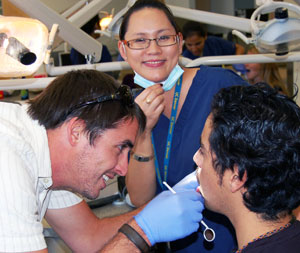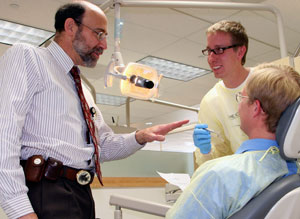Lessons in Oral Health
Dental Eams Part of MD Training
Tonia Twichell
 (November 2012) Physicians and dentists went their separate ways in the mid-1800s, divorcing the care of mouth from the rest of the body for well over a century.
(November 2012) Physicians and dentists went their separate ways in the mid-1800s, divorcing the care of mouth from the rest of the body for well over a century.
Until a U.S. Surgeon General’s landmark report Oral Health in America in 2000, there had been little reason to consider reconciliation.
“When I was in school we weren’t even taught to look at teeth,” says Mark Deutchman, MD, professor of family medicine and Colorado Area Health Education Center (AHEC) associate director for multidisciplinary education. “There wasn’t anything we could do about them. They were just things that got in the way when we looked at the tonsils.”
But the report broke ground by calling for oral health education for all health providers to combat problems that today are considered entirely preventable: escalating numbers of children with tooth decay and adults with
Children are getting a lot of the attention because the need is reaching crisis levels, Deutchman says. Dental disease is the nation’s most common chronic disease in children.
“The number one use of the operating room at Children’s Hospital is total mouth reconstruction,” says Anita Glicken, former associate dean of CU’s Child Health Associate/Physician Assistant Program.
That surgery costs between $8,000 and $12,000, Deutchman says, pointing out, “You can buy a lot of prevention for that.”
Even so, why would non-dentists be tapped to perform oral exams? Keeping oral care in the realm of dentistry would work if not for the fact that a large percentage of the U.S. population doesn’t visit dentists except in emergencies. Forty percent of Coloradans do not have dental insurance, and few children have a dental home by age 1, which health care providers recommend, Deutchman says.
But, the report reasoned, if other providers from physician assistants to nurse practitioners and physicians were able to recognize decay, they could stop the disease process early by providing oral exams, hygiene and diet advice, and
The report set in motion changes that still reverberate in health care campuses around the country, particularly at the University of Colorado Anschutz Medical Campus, where:
- Dental students teach all medical and physician assistant students how to perform a basic oral exam and apply
a protective  fluoride varnish.
fluoride varnish.
- Oral health care is offered as part of the curriculum in three of four years for medical students and all three years for physician assistants.
- Medical school faculty members teach dental students how to identify broader health issues like diabetes, HIV and cardiovascular problems through oral exams.
- The Frontier Center, funded by Delta Dental of Colorado Foundation at the School of Dental Medicine, encourages interprofessional oral health education for all health sciences students.
- Through Cavity Free at Three, a Colorado-based program with roots in CU’s AHEC program, physicians and students teach health care workers around the state how to perform oral care checks on children and pregnant women. Training includes oral screening, identifying
disease , a risk assessmentand a fluoride varnish; instructional pamphlets have been translated into nine languages including Russian, Arabic and Chinese, says Karen Savoie, AHEC director of education.
- Smiles for Life, a national initiative, offers free tutorials on recognizing oral disease in all populations; Deutchman, one of its authors, wrote two of the eight educational modules.
Glicken said she’d never thought about teaching oral care to students until she was invited to a conference by Deutchman, who was already introducing oral care into the School of Medicine curriculum.
“It took me about two hours to realize the incredible gap in dental care,” she says. “Two years ago I knew nothing about this. Now four national PA organizations are engaged.”
Providers are paid extra by Medicaid for including these services in well-child visits, but in some
“We try to encourage general dentists to see little kids since there are so few pediatric dentists, particularly outside the Front Range,”
Dental schools historically have focused more on repairing disease than on
“The School of Dental Medicine is now at the forefront of teaching interprofessional care, increasing exposure to pediatric dentistry and preparing future dentists with an emphasis on prevention,” Brunson says.
Getting children’s oral health under control is important so they don’t become adults with oral health problems, Deutchman says.
“Baby teeth are the predictor of adult oral health,”
For adults, the problem is less about cavities and more about gums and what their condition means for overall health.
“For example, a gum inflammation can be related to vascular disease,”
The first exposure most CU medical students have to oral care comes in their second year of school with a lecture on the connection between oral health and overall health. Later, they spend a morning with dental students who teach them the basics of an oral exam.
“The medical students leave here varnished ear to ear,” Brunson says. “But just as important as learning the basics of oral health is the idea that different disciplines should work together.”
Now medical and dental students volunteer to run a drop-in clinic at the National Western Stock Show each January. They also travel to Fort Morgan to work with children in the Somali population through Cavity Free at Three.
And dental and medical students are starting a student interest group to serve needy communities, says fourth-year medical student Dave Baumgartner, who like Deutchman is the son of a dentist and who says the idea of expanding oral care impressed him as “logical and intuitive. I jumped right on board.”
The students’ interest is gratifying for Brunson, who came to CU after 15 years with the state Department of Health and Environment.
“It became evident to me that I might be able to have more impact here on campus,” Brunson says. “At the state, I was trying to change the behavior of existing practitioners … But then I realized that students practice what they learn in school and this is the place to be.”